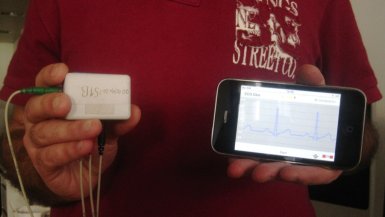Students: Hossein Mamaghanian
Contacts: Dr. Giovanni Ansaloni, Prof. David Atienza
Motivation
According to the World Health Organization, cardiovascular diseases are the number one cause of death worldwide, responsible for an estimated 17.1 million deaths in 2004 (i.e., 29% of all deaths worldwide) and economic fallout in billions. These increasingly prevalent cardiac diseases are requiring escalating levels of supervision and medical management, which are contributing to skyrocketing health care costs and, more importantly, are unsustainable for traditional health care infrastructures.
Wireless body sensor networks (WBSN) promise to enable inexpensive, continuous and remote health monitoring required in next-generation ambulatory personal telecardiology or e-cardiology systems. A WBSN-enabled electrocardiogram (ECG) monitor consists of wearable, miniaturized and wireless sensors able to measure and wirelessly report cardiac signals to a WBSN coordinator, which is responsible for reporting them to the tele-health provider.
Recently, the realization of wireless-enabled ultra-lowpower ECG monitors for ambulatory use has been receiving significant industrial and academic interest. Yet, state-of-theart ECG monitors fall short in terms of either clinical relevance and/or autonomy figure, primarily because they transmit uncompressed ECG data over power-hungry wireless links. ECG is largely sparse (and thus compressible) and stateof- the-art wearable sensors included low-power microcontroller capable of supporting embedded processing. It is today widely acknowledged that the achievement of truly WBSN-enabled personal ECG monitoring systems requires more breakthroughs not only in terms of ultra-low-power readout electronics and radios, but also and increasingly so, in terms of embedded ECG compression.

Embed of video is only possible from Mediaspace, Vimeo or Youtube
OUR APPROACH
Capitalizing on the sparsity of ECG signals, we propose to apply the emerging compressed sensing (CS) approach for a low-complexity, real-time and energy-aware ECG signal compression on WBSN motes. This is motivated by the observation that this new signal acquisition/compression paradigm is particularly well suited for low-power implementations because it dramatically reduces the need for resource- (both processing and storage) intensive DSP operations on the encoder side. The price to pay for these advantages however, is a more complex decoder. In general, reconstruction algorithms for CS recovery are computationally expensive, because they involve large and dense matrix operation, which prevents their real-time implementation on embedded platforms.
This project has developed a real time, energy-aware wireless ECG monitoring system. The main contributions of this work are: (1) a novel CS approach that precludes large and dense matrix operations both at compression and recovery, and (2) several platform-dependent optimizations and parallelization techniques to achieve real-time CS recovery. To the best of our knowledge, this work is the first to demonstrate CS as an advantageous real-time and energyefficient ECG compression technique, with a computationally light and energy-efficient ECG encoder on the state-of-the-art ShimmerTM wearable sensor node and a real-time decoder running on an iPhone as a representative of compact embedded (CE) device (acting as a WBSN coordinator).
For further details, please read this recently published work based on 3D-ICE:
K. Kanoun, H. Mamaghanian, N. Khaled and D. Atienza Alonso, “A Real-Time Compressed Sensing-Based Personal Electrocardiogram Monitoring System“, accepted for Proceedings of the IEEE/ACM 2011 Design, Automation and Test in Europe Conference (DATE 2011), Grenoble, France, March 14-18, 2011.